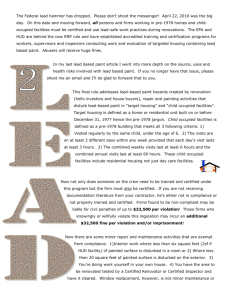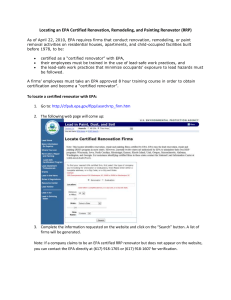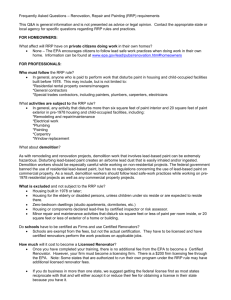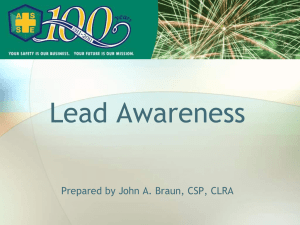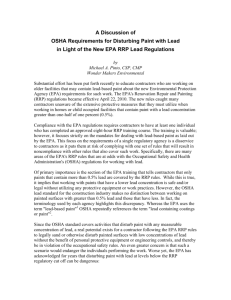Assist Program - Georgia Tech OSHA Consultation Program
advertisement
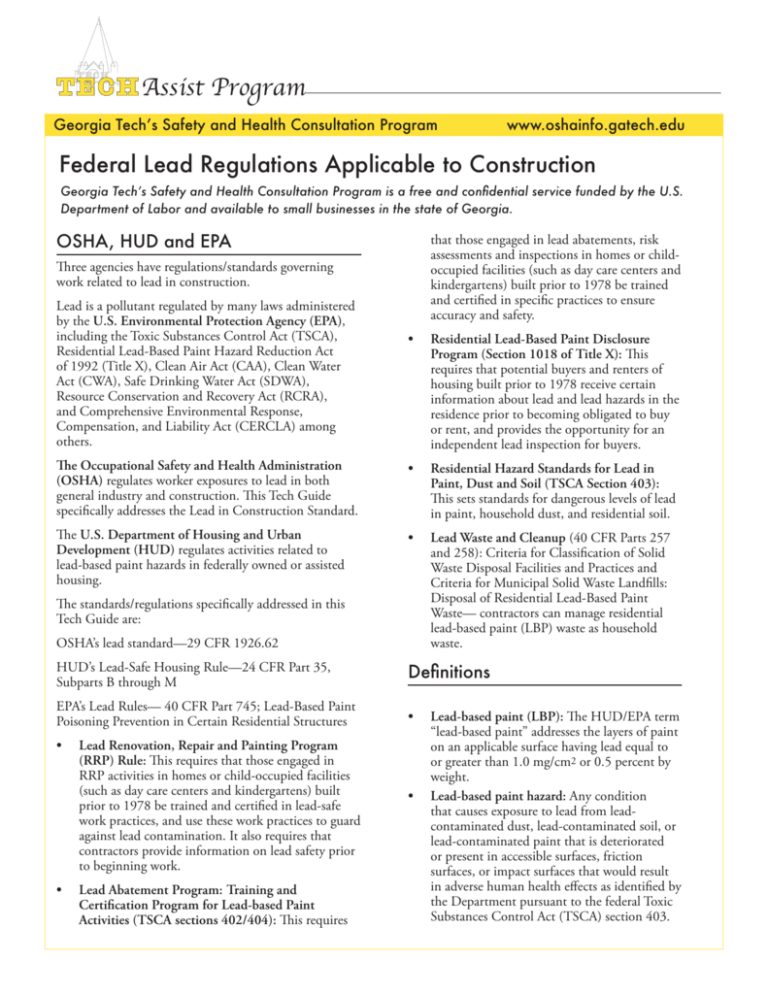
Assist Program Georgia Tech’s Safety and Health Consultation Program www.oshainfo.gatech.edu Federal Lead Regulations Applicable to Construction Georgia Tech’s Safety and Health Consultation Program is a free and confidential service funded by the U.S. Department of Labor and available to small businesses in the state of Georgia. OSHA, HUD and EPA Three agencies have regulations/standards governing work related to lead in construction. that those engaged in lead abatements, risk assessments and inspections in homes or childoccupied facilities (such as day care centers and kindergartens) built prior to 1978 be trained and certified in specific practices to ensure accuracy and safety. Lead is a pollutant regulated by many laws administered by the U.S. Environmental Protection Agency (EPA), including the Toxic Substances Control Act (TSCA), Residential Lead-Based Paint Hazard Reduction Act of 1992 (Title X), Clean Air Act (CAA), Clean Water Act (CWA), Safe Drinking Water Act (SDWA), Resource Conservation and Recovery Act (RCRA), and Comprehensive Environmental Response, Compensation, and Liability Act (CERCLA) among others. • Residential Lead-Based Paint Disclosure Program (Section 1018 of Title X): This requires that potential buyers and renters of housing built prior to 1978 receive certain information about lead and lead hazards in the residence prior to becoming obligated to buy or rent, and provides the opportunity for an independent lead inspection for buyers. The Occupational Safety and Health Administration (OSHA) regulates worker exposures to lead in both general industry and construction. This Tech Guide specifically addresses the Lead in Construction Standard. • Residential Hazard Standards for Lead in Paint, Dust and Soil (TSCA Section 403): This sets standards for dangerous levels of lead in paint, household dust, and residential soil. The U.S. Department of Housing and Urban Development (HUD) regulates activities related to lead-based paint hazards in federally owned or assisted housing. • Lead Waste and Cleanup (40 CFR Parts 257 and 258): Criteria for Classification of Solid Waste Disposal Facilities and Practices and Criteria for Municipal Solid Waste Landfills: Disposal of Residential Lead-Based Paint Waste— contractors can manage residential lead-based paint (LBP) waste as household waste. The standards/regulations specifically addressed in this Tech Guide are: OSHA’s lead standard—29 CFR 1926.62 HUD’s Lead-Safe Housing Rule—24 CFR Part 35, Subparts B through M EPA’s Lead Rules— 40 CFR Part 745; Lead-Based Paint Poisoning Prevention in Certain Residential Structures • Lead Renovation, Repair and Painting Program (RRP) Rule: This requires that those engaged in RRP activities in homes or child-occupied facilities (such as day care centers and kindergartens) built prior to 1978 be trained and certified in lead-safe work practices, and use these work practices to guard against lead contamination. It also requires that contractors provide information on lead safety prior to beginning work. • Lead Abatement Program: Training and Certification Program for Lead-based Paint Activities (TSCA sections 402/404): This requires Definitions • Lead-based paint (LBP): The HUD/EPA term “lead-based paint” addresses the layers of paint on an applicable surface having lead equal to or greater than 1.0 mg/cm2 or 0.5 percent by weight. • Lead-based paint hazard: Any condition that causes exposure to lead from leadcontaminated dust, lead-contaminated soil, or lead-contaminated paint that is deteriorated or present in accessible surfaces, friction surfaces, or impact surfaces that would result in adverse human health effects as identified by the Department pursuant to the federal Toxic Substances Control Act (TSCA) section 403. Comparison of OSHA Construction, EPA, and HUD Lead Programs* This table summarized the similarities and differences between the three agency’s requirements, specifically as it related to lead and lead-based paint. OSHA 1926.62 HUD EPA LBP EPA RRP EPA Other Protect children, particularly those <6 Protect children, particularly those <6 Protect children, particularly those <6 Protect public health and the environment Exposure reduction during and after construction, RRP, and maintenance including cleanup and clearance. Exposure reduction during and after abatement and maintenance, including cleanup and clearance Exposures after renovation, repair and painting (RRP), including maintenance, and methods during RRP to ensure low exposures afterward Prevent releases to the environment; control of hazardous waste Any employee potentially exposed to lead during construction Pre-1978 housing, and child-occupied facilities in that housing Pre-1978 housing and child-occupied facilities All pre-1978 housing, including federal, and child-occupied facilities Any project that could release lead to water or air. All construction work sites where lead is present. Federally owned housing being disposed of Federally owned housing Any project that generates lead waste Federally assisted housing Federally assisted housing Requires certification of firms, employees doing work covered by EPA certification rule (inspection, risk assessment, abatement, design) Requires certification of firms, employees doing work covered by certification rule (inspection, risk assessment, abatement) Requires certification of firms, trained employees doing RRP work. 40 CFR Part 257 and 258 Construction and demolition (C&D) landfills are allowed to accept residential leadbased paint (LBP) waste for disposal. This applies to residential LBP waste from abatement, rehabilitation, renovation, or remodeling in homes, residences, and other households. Some states have more strigent waste disposal requirements. Does not cover elderly housing, single-room units, all non-residential non-child-occupied facilities Does not cover elderly housing, single-room units, all non-residential non-child-occupied facilities Goals Protect construction employees Focus Exposure reduction during construction Coverage Requires certification of firms, trained employees doing RRP work. Gaps Does not cover Does not cover elderly self-employed or housing, single-room units, independent contractors. all non-residential (except child-occupied facilities in pre-1978 residences) For more information, contact the Safety and Health Consultation Program Atlanta, Georgia 30332–0837 404.407.7431 www.oshainfo.gatech.edu Comparison of OSHA Construction, EPA, and HUD Lead Programs (cont.)* OSHA 1926.62 HUD EPA LBP EPA RRP Requires testing of paint (x-ray fluorescence testing, or paint chip collection and EPA-recognized lead laboratory analysis) or presumption of presence of lead-based paint before work Requires testing of paint (x-ray fluorescence testing, or paint chip collection and EPA-recognized lead laboratory analysis) or presumption of presence of lead-based paint before work Allows RRP certified individual to EPA Other Differences Generally, requires air monitoring if an employee may be exposed, and may require blood monitoring if exposure exists. • • • collect paint chip samples (requires EPA-recognized lead laboratory analysis)* use of EPArecognized test kits presume of presence of lead-based paint before work. If RRP-certified individual tests surfaces, must test EACH and EVERY component that will be affected. *States may require certified inspector. Does not require cleanRequires clean-up and up at the end of a project clearance testing at the end of all but the smallest projects. Clearance must be done by certified independent party. Requires clean-up and clearance testing at the end of abatement projects (must be done by certified inspector/ risk assessor). Requires clean-up and cleanup verification at the end of RRP projects (which can be done by certified renovator). Allows most work practices if appropriate engineering controls and/or PPE are used Bans six work practices. These include EPA’s 3 prohibited work practices plus: heat guns that char paint, dry scraping or sanding farther than 1 ft. of electrical outlets, and use of a volatile stripper in poorly ventilated space. Bans three work practices (open flame burning or torching, heat guns above 1100 degrees F, machine removal without HEPA vacuum attachment). Bans three work practices (open flame burning or torching, heat guns above 1100 degrees F, machine removal without HEPA vacuum attachment). Requires monitoring during work Requires monitoring during Requires monitoring work during work Requires monitoring during work Makes no distinction between lead abatement and other RRP work, and other general construction. Clearly separates lead abatement from all other work Clearly separates RRP work from lead abatement and all other non-lead work. Clearly separates lead abatement from all other work For more information, contact the Safety and Health Consultation Program Atlanta, Georgia 30332–0837 404.407.7431 www.oshainfo.gatech.edu Comparison of OSHA Construction, EPA, and HUD Lead Programs (cont.)* OSHA 1926.62 HUD EPA LBP EPA RRP Requires onsite certified supervisor. Requires onsite certified renovator. EPA Other Differences (cont.) Requires competent person. Requires employee training All workers and supervisors must complete a HUDapproved curriculum in lead safe work practices, except that non-certified renovation workers need only on-the-job training if they are supervised by a certified LBP abatement supervisor who is also a certified renovator. Renovation firms must be certified. At least one certified renovator must be at the job or available when work is being done. Requires certification of lead abatement firms and employees. Requires RRP contractors to be certified. RRP workers must receive on-thejob training from the certified renovator. (The certified renovator may be a certified LBP abatement supervisor who has completed the 4-hour RRP refresher course.) Does not require notification prior to work Requires notification prior to work Requires notification prior to work for abatement projects. Requires no notification (states may have notification requirements) Has no threshold minimum amounts of paint disturbance that trigger lead activities. HUD has a lower de minimis threshold (2 sq. ft. per room interior, 20 sq. ft. exterior or 10 percent of a small component type) than EPA for lead-safe work practices. HUD also uses this lower threshold for clearance and occupant notification. EPA’s interior threshold (6 sq. ft. per room) for minor repair and maintenance activities is higher than HUD’s de minimis threshold. EPA’s interior threshold (6 sq. ft. per room) for minor repair and maintenance activities is higher than HUD’s de minimis threshold. *Table adapted from Regulatory Review of 29 CFR 1926.62, Lead in Construction, August 2007 < http://www.osha.gov/dea/lookback/leadconstruction-review.html> and Fact Sheet: EPA Certified Renovation Firms and Certified Renovators; Additional Requirements of HUD’s Lead Safe Housing Rule < http://www.hud.gov/offices/lead/enforcement/lshr_rrp_changes.cfm>. Viewed 31 October 2012. Who to Contact for More Information On These Regulations? Section 18 of the Occupational Safety and Health Act of 1970 (the Act) encourages States to develop and operate their own job safety and health programs. OSHA approves and monitors State plans. There are currently 22 States and jurisdictions operating complete State plans (covering both the private sector and State and local government employees) and 5 Connecticut, Illinois, New Jersey, New York and the Virgin Islands - which cover public employees only. These states worker protections must be “at least as effective” as the protection provided by the federal program. EPA has the authority to authorize states, tribes and territories to administer their own RRP and LBP programs that would operate in lieu of the EPA regulations. When a state, tribe or territory becomes authorized, contractors and training providers working in these areas and consumers living there should contact the appropriate state, tribal or territorial program office Currently (Nov 2012) the following states have been authorized by EPA to to administer the RRP program: Alabama, Georgia, Iowa, Kansas, Massachusetts, Mississippi, North Carolina, Oregon, Rhode Island, Utah, Washington, and Wisconsin. Go to this link to find the state, tribes and territories that admister the LBP program. In EPA Region IV (the southeast region), all states except South Carolina and Florida have been authorized to administer their own LBP program. HUD maintains a Web page for its Office of Healthy Homes and Lead Hazard Control. Information on their regulations and requirements may be found at that site.
![[Agency] recognizes the hazards of lead](http://s3.studylib.net/store/data/007301017_1-adfa0391c2b089b3fd379ee34c4ce940-300x300.png)
